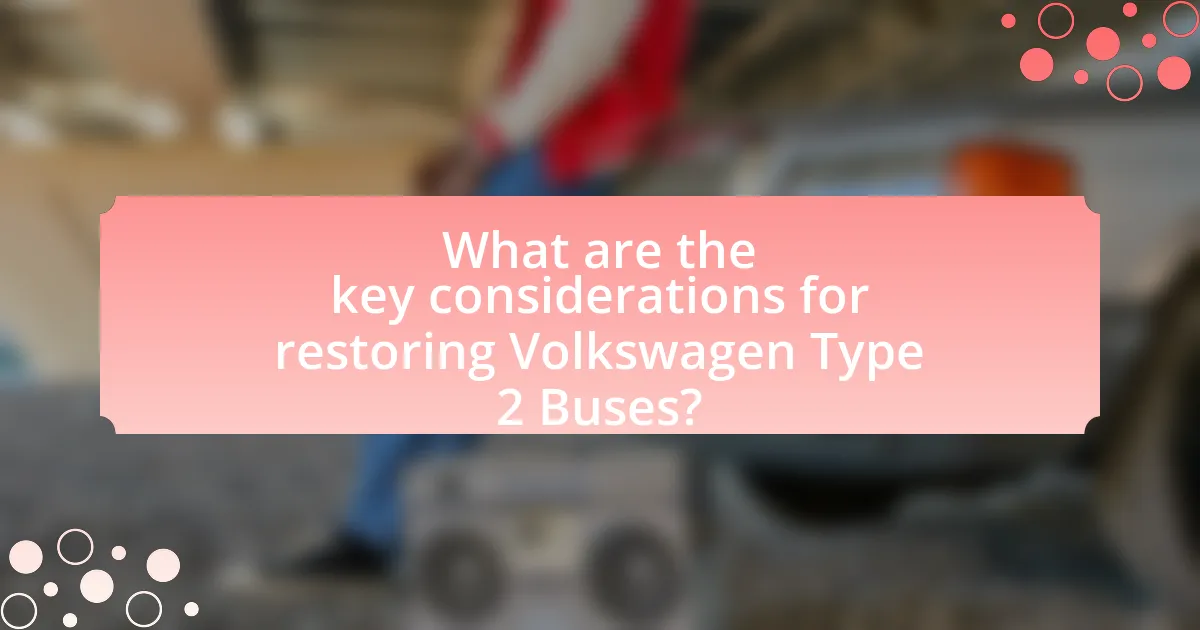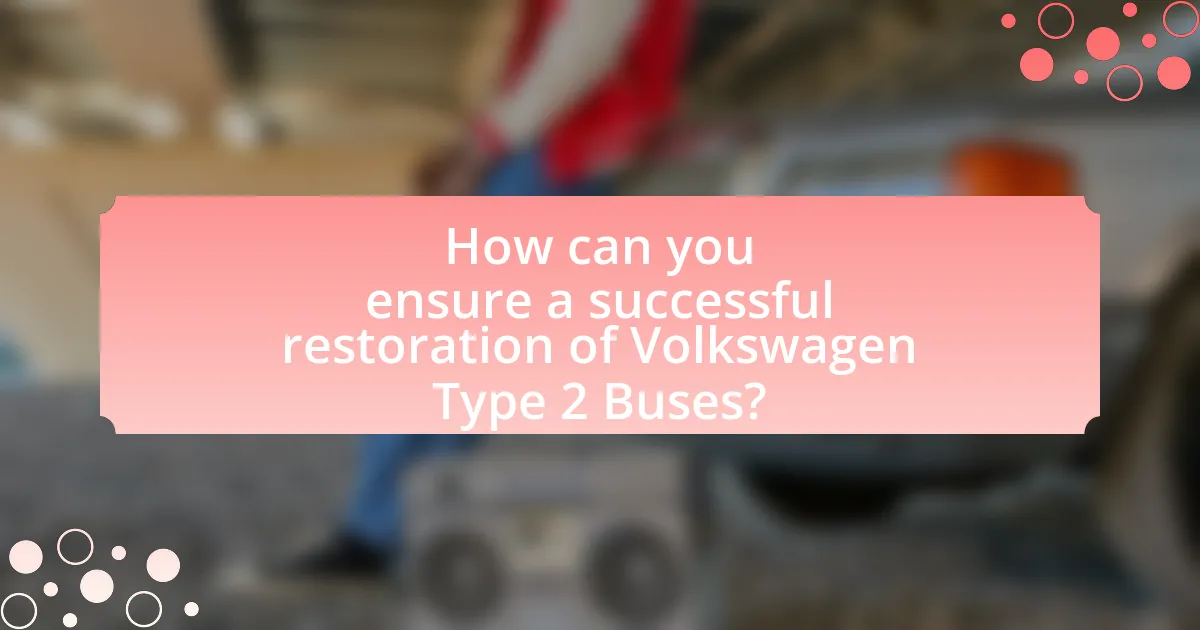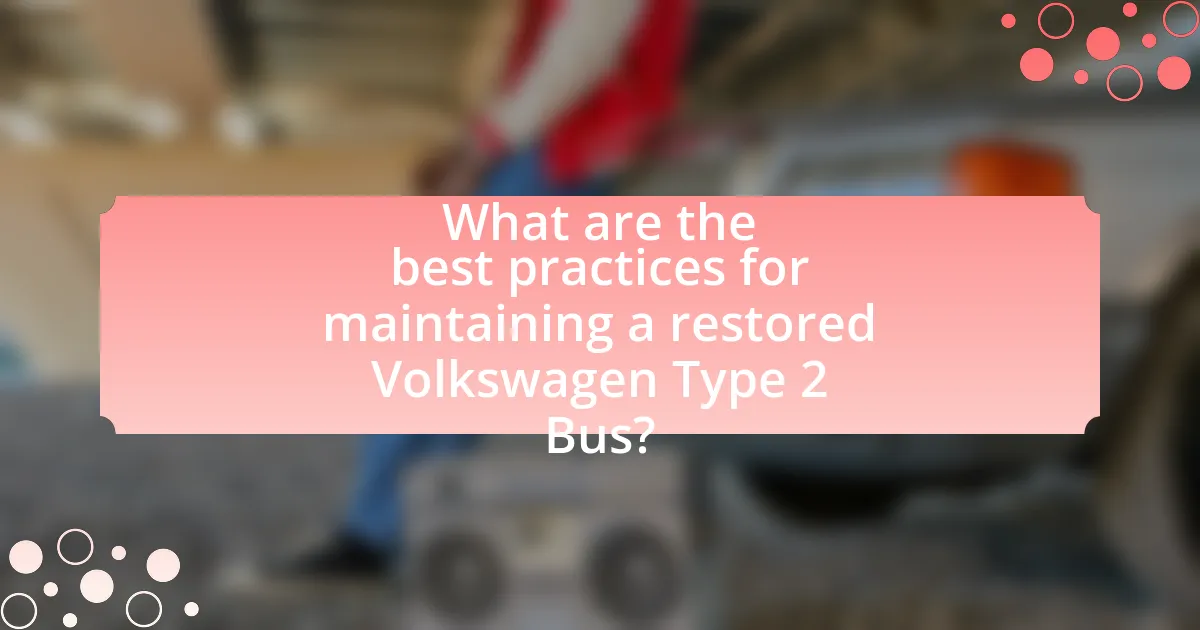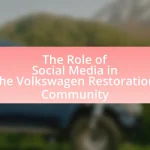The article focuses on the comprehensive approach to restoring Volkswagen Type 2 Buses, emphasizing key considerations such as assessing structural integrity, sourcing authentic parts, and understanding model year differences. It outlines the steps for evaluating the vehicle’s condition, inspecting specific areas for damage, and determining the authenticity of parts. Essential tools and materials for the restoration process are detailed, along with common challenges faced by restorers, including rust management and sourcing rare components. The article also provides best practices for maintaining the vehicle’s original character and offers resources for enthusiasts seeking support and knowledge in their restoration projects.

What are the key considerations for restoring Volkswagen Type 2 Buses?
Key considerations for restoring Volkswagen Type 2 Buses include assessing the vehicle’s structural integrity, sourcing authentic parts, and understanding the specific model year differences. Evaluating the bus’s body for rust and damage is crucial, as the Type 2 is known for corrosion issues, particularly in the floor and wheel wells. Authentic parts are essential for maintaining the vehicle’s value and originality; many enthusiasts prefer OEM components. Additionally, recognizing the variations in specifications and features across different model years helps ensure that restorations are accurate and true to the original design. These considerations are vital for achieving a successful and valuable restoration.
How do you assess the condition of a Volkswagen Type 2 Bus before restoration?
To assess the condition of a Volkswagen Type 2 Bus before restoration, conduct a thorough inspection of the vehicle’s body, chassis, engine, and interior. Start by examining the body for rust, dents, and previous repairs, as these factors significantly impact restoration costs and efforts. Next, inspect the chassis for structural integrity, checking for any signs of corrosion or damage that could affect safety and performance. Evaluate the engine’s condition by checking for leaks, unusual noises, and overall functionality, as a well-maintained engine can reduce restoration complexity. Finally, assess the interior for wear and tear, including seats, dashboard, and electrical components, as these elements contribute to the overall restoration project. Historical data indicates that a comprehensive pre-restoration assessment can save time and resources, ensuring a more successful restoration outcome.
What specific areas should be inspected for damage or wear?
The specific areas that should be inspected for damage or wear in Volkswagen Type 2 Buses include the body panels, floor pans, suspension components, and engine bay. Body panels often suffer from rust and corrosion, particularly around the wheel wells and lower edges. Floor pans can deteriorate due to moisture exposure, leading to structural issues. Suspension components, such as bushings and shock absorbers, should be checked for wear that affects handling and safety. The engine bay requires inspection for leaks, worn belts, and hoses that can impact performance. Regular inspections of these areas are crucial for maintaining the vehicle’s integrity and safety.
How can you determine the authenticity of parts and components?
To determine the authenticity of parts and components, verify their origin through documentation, such as invoices or certificates of authenticity. Authentic parts often have specific markings, serial numbers, or logos that match manufacturer specifications. For example, Volkswagen Type 2 parts typically feature unique identifiers that can be cross-referenced with official parts catalogs. Additionally, consulting expert restorers or joining dedicated forums can provide insights into distinguishing genuine parts from replicas, as experienced enthusiasts often share knowledge about subtle differences in design and materials.
What tools and materials are essential for the restoration process?
Essential tools and materials for the restoration process of Volkswagen Type 2 Buses include a variety of hand tools, power tools, and specific materials. Key hand tools consist of wrenches, screwdrivers, pliers, and hammers, which are necessary for disassembly and assembly tasks. Power tools such as grinders, drills, and sanders facilitate efficient metalwork and body repairs. Additionally, materials like rust treatment solutions, body filler, primer, and paint are crucial for restoring the bus’s exterior and protecting it from future corrosion. The use of these tools and materials is supported by restoration best practices, which emphasize the importance of proper equipment in achieving high-quality results.
Which hand tools are necessary for a successful restoration?
Essential hand tools for a successful restoration of Volkswagen Type 2 Buses include wrenches, screwdrivers, pliers, hammers, and a socket set. These tools are critical for disassembling, repairing, and reassembling various components of the bus. Wrenches and socket sets facilitate the loosening and tightening of bolts and nuts, while screwdrivers are necessary for handling screws in different areas. Pliers assist in gripping and bending materials, and hammers are useful for shaping and aligning parts. The combination of these tools ensures that restorers can effectively manage the intricate tasks involved in the restoration process.
What types of materials should be sourced for repairs and replacements?
For repairs and replacements of Volkswagen Type 2 Buses, it is essential to source high-quality materials such as OEM (Original Equipment Manufacturer) parts, aftermarket components that meet or exceed OEM specifications, rust-resistant metal for bodywork, durable rubber seals for windows and doors, and high-grade upholstery materials for interior restoration. Sourcing OEM parts ensures compatibility and reliability, while aftermarket components can provide cost-effective alternatives without compromising quality. Rust-resistant metal is crucial for longevity, as these vehicles are prone to corrosion. Durable rubber seals prevent leaks and enhance insulation, and high-grade upholstery materials improve the aesthetic and comfort of the bus.
What are the common challenges faced during the restoration of Volkswagen Type 2 Buses?
Common challenges faced during the restoration of Volkswagen Type 2 Buses include sourcing rare parts, dealing with rust and corrosion, and ensuring structural integrity. Sourcing rare parts is difficult due to the age of the vehicles, as many original components are no longer manufactured, leading restorers to rely on aftermarket suppliers or salvage yards. Rust and corrosion are prevalent issues, especially in the body and undercarriage, requiring extensive repair work to maintain safety and aesthetics. Ensuring structural integrity is crucial, as many buses have been modified over the years, necessitating careful assessment and potential reinforcement of the chassis and body to meet safety standards.
How can rust and corrosion be effectively managed?
Rust and corrosion can be effectively managed through regular maintenance, protective coatings, and proper storage. Regular maintenance involves inspecting metal surfaces for signs of rust and addressing them promptly, as untreated rust can spread and compromise structural integrity. Protective coatings, such as paint or galvanization, create a barrier against moisture and oxygen, which are essential for rust formation. Additionally, storing vehicles in dry, climate-controlled environments minimizes exposure to humidity and moisture, further reducing the risk of corrosion. These methods are supported by studies indicating that proactive measures can significantly extend the lifespan of metal components in vehicles, including classic models like the Volkswagen Type 2 Bus.
What strategies can be employed to deal with missing or damaged parts?
To deal with missing or damaged parts in Volkswagen Type 2 Buses, restoration strategies include sourcing replacement parts, utilizing fabrication techniques, and engaging in community support. Sourcing replacement parts can involve searching for original equipment manufacturer (OEM) parts or high-quality aftermarket alternatives, which ensures compatibility and maintains the vehicle’s integrity. Fabrication techniques, such as welding or 3D printing, can be employed to create custom parts when originals are unavailable, allowing for precise fitting and functionality. Engaging with online forums and local clubs dedicated to Volkswagen restoration can provide valuable resources, including advice, part leads, and shared experiences from other enthusiasts, enhancing the restoration process. These strategies collectively ensure that missing or damaged parts are effectively addressed, preserving the vehicle’s performance and aesthetic.

How can you ensure a successful restoration of Volkswagen Type 2 Buses?
To ensure a successful restoration of Volkswagen Type 2 Buses, follow a structured approach that includes thorough planning, sourcing quality parts, and skilled labor. Begin by assessing the bus’s condition to identify necessary repairs and restorations, which allows for a clear restoration plan. Utilize original or high-quality aftermarket parts to maintain authenticity and performance, as using subpar components can lead to future issues. Engage experienced mechanics or restorers familiar with Volkswagen Type 2 Buses, as their expertise can significantly impact the quality of the restoration. Historical data shows that buses restored with original specifications retain higher resale values, reinforcing the importance of quality in the restoration process.
What steps should be followed in the restoration process?
The steps that should be followed in the restoration process of Volkswagen Type 2 Buses include assessment, disassembly, repair, and reassembly. First, assess the condition of the bus to identify areas needing attention, such as rust or mechanical issues. Next, disassemble the bus carefully, documenting each part for reference. After disassembly, repair any damaged components, which may involve welding, painting, or replacing parts. Finally, reassemble the bus, ensuring all parts are correctly fitted and functional. This structured approach ensures a thorough restoration, preserving the vehicle’s integrity and value.
How do you create a detailed restoration plan?
To create a detailed restoration plan for a Volkswagen Type 2 Bus, begin by conducting a thorough assessment of the vehicle’s current condition, identifying areas that require repair or replacement. This assessment should include evaluating the body, engine, interior, and electrical systems. Next, outline specific goals for the restoration, such as maintaining originality or enhancing performance.
Following the goals, develop a step-by-step timeline that prioritizes tasks based on complexity and resource availability. Allocate a budget that covers parts, labor, and unexpected expenses, ensuring to research and source quality components. Document each phase of the restoration process, including photographs and notes, to track progress and maintain organization.
Finally, consult restoration guides and forums specific to Volkswagen Type 2 Buses to gather insights and best practices from experienced restorers, reinforcing the plan’s effectiveness with proven strategies.
What is the importance of documenting the restoration process?
Documenting the restoration process is crucial for ensuring transparency, accountability, and knowledge transfer. This practice allows restorers to track progress, identify challenges, and implement solutions effectively. Furthermore, comprehensive documentation serves as a valuable resource for future restorations, providing insights into techniques, materials used, and lessons learned. According to the National Park Service, thorough documentation can enhance the historical integrity of the restoration, ensuring that the original character of the Volkswagen Type 2 Bus is preserved while also facilitating maintenance and repairs in the future.
How can you maintain the original character of the Volkswagen Type 2 Bus during restoration?
To maintain the original character of the Volkswagen Type 2 Bus during restoration, use authentic parts and materials that match the original specifications. This includes sourcing OEM (Original Equipment Manufacturer) components, which ensures that the vehicle retains its historical integrity and aesthetic appeal. Additionally, adhere to the original color schemes and interior designs, as these elements are crucial to the bus’s identity. Historical records indicate that the Volkswagen Type 2 Bus was produced with specific design features and materials, making it essential to reference restoration guides and original factory specifications to ensure accuracy.
What are the best practices for preserving original paint and finishes?
The best practices for preserving original paint and finishes on Volkswagen Type 2 Buses include regular cleaning, controlled environmental conditions, and the application of protective coatings. Regular cleaning with mild soap and water prevents dirt buildup that can damage the paint. Maintaining a stable environment, with low humidity and moderate temperatures, helps prevent oxidation and fading. Additionally, applying a high-quality wax or sealant provides a protective barrier against UV rays and contaminants, which can degrade the original finish over time. These methods are supported by automotive restoration experts who emphasize the importance of preservation techniques to maintain the vehicle’s aesthetic and value.
How can you balance modern upgrades with vintage authenticity?
To balance modern upgrades with vintage authenticity in restoring Volkswagen Type 2 Buses, prioritize upgrades that enhance functionality while preserving original aesthetics. For instance, integrating modern safety features like disc brakes or LED lighting can improve performance without altering the classic look. Historical restoration guidelines suggest maintaining original parts where possible, as this retains the vehicle’s character and value. According to the Volkswagen Club of America, preserving the original bodywork and paint style while updating mechanical systems is essential for maintaining authenticity.

What are the best practices for maintaining a restored Volkswagen Type 2 Bus?
The best practices for maintaining a restored Volkswagen Type 2 Bus include regular inspections, proper storage, and routine maintenance of mechanical and electrical systems. Regular inspections should focus on checking for rust, leaks, and wear in critical components like the brakes and suspension. Proper storage in a dry, climate-controlled environment prevents moisture damage and rust formation. Routine maintenance should involve changing the oil every 3,000 miles, checking tire pressure, and ensuring that the electrical system, including the battery and wiring, is in good condition. Following these practices helps preserve the vehicle’s integrity and longevity, as evidenced by the fact that regular maintenance can extend the lifespan of classic vehicles significantly, often by decades.
How can regular maintenance extend the life of a restored Volkswagen Type 2 Bus?
Regular maintenance can significantly extend the life of a restored Volkswagen Type 2 Bus by ensuring that all mechanical and structural components function optimally. Routine checks on the engine, transmission, brakes, and electrical systems help identify and address potential issues before they escalate into major problems. For instance, regular oil changes and fluid checks prevent engine wear and overheating, which are common causes of failure in vintage vehicles. Additionally, maintaining the bus’s bodywork through rust prevention and paint protection can preserve its structural integrity and aesthetic appeal, contributing to its longevity. Statistics show that vehicles with consistent maintenance can last up to 50% longer than those that are neglected, highlighting the importance of a proactive approach to upkeep.
What routine checks should be performed to ensure optimal performance?
Routine checks for optimal performance of Volkswagen Type 2 Buses include inspecting the engine oil level and quality, checking the coolant level, examining the brake fluid, and assessing tire pressure and tread depth. Regularly monitoring engine oil ensures proper lubrication and prevents wear, while maintaining coolant levels prevents overheating. Brake fluid checks are crucial for safe stopping power, and proper tire maintenance enhances handling and fuel efficiency. These checks are essential for maintaining the vehicle’s reliability and performance over time.
How can you protect the bus from environmental damage?
To protect the bus from environmental damage, apply a high-quality protective coating to the exterior surfaces. This coating acts as a barrier against moisture, UV rays, and pollutants, which can lead to rust and paint degradation. Regular maintenance, including washing and waxing, further enhances this protection by removing contaminants that can cause corrosion. Additionally, storing the bus in a climate-controlled environment minimizes exposure to extreme weather conditions, which can accelerate wear and tear.
What resources are available for Volkswagen Type 2 Bus restoration enthusiasts?
Volkswagen Type 2 Bus restoration enthusiasts have access to a variety of resources, including specialized forums, restoration guides, parts suppliers, and community events. Online forums such as The Samba and VWVortex provide platforms for sharing knowledge and experiences among enthusiasts. Restoration guides, like “How to Restore Your Volkswagen Bus” by Tom Wilson, offer step-by-step instructions and insights into the restoration process. Parts suppliers, including Bus Depot and West Coast Metric, supply authentic and aftermarket parts essential for restoration projects. Additionally, community events such as VW shows and meetups foster networking and knowledge sharing among enthusiasts, enhancing the restoration experience.
Which online communities and forums provide valuable insights and support?
Online communities and forums that provide valuable insights and support for restoring Volkswagen Type 2 Buses include The Samba, VWVortex, and Facebook groups dedicated to Volkswagen enthusiasts. The Samba is a well-established forum with a wealth of information on restoration techniques, parts sourcing, and community support, boasting thousands of active members sharing their experiences. VWVortex offers a broader discussion platform for various Volkswagen models, including dedicated threads for Type 2 restoration, where users exchange tips and advice. Additionally, Facebook groups like “Volkswagen Type 2 Bus Owners” facilitate real-time interaction and support among members, allowing for the sharing of resources and personal restoration stories. These platforms collectively serve as essential resources for enthusiasts seeking guidance and community in their restoration projects.
What books or guides are recommended for in-depth restoration knowledge?
For in-depth restoration knowledge of Volkswagen Type 2 Buses, “Volkswagen Type 2: The Essential Buyer’s Guide” by John Gunnell and “How to Restore Volkswagen Bus” by Tom Wilson are highly recommended. These books provide comprehensive insights into the restoration process, covering essential techniques, parts sourcing, and maintenance tips specific to Type 2 Buses. Their detailed illustrations and step-by-step instructions make them valuable resources for both novice and experienced restorers.
What practical tips can enhance the restoration experience of Volkswagen Type 2 Buses?
To enhance the restoration experience of Volkswagen Type 2 Buses, it is essential to create a detailed plan that includes thorough research on parts availability and restoration techniques. This approach ensures that restorers are well-informed about the specific needs of their vehicle, as the Volkswagen Type 2 has unique components that may require specialized knowledge or sourcing from dedicated suppliers. Additionally, joining online forums and local clubs can provide valuable insights and support from fellow enthusiasts who have faced similar challenges, fostering a community of shared knowledge and resources. Engaging with restoration guides and manuals specific to the Volkswagen Type 2 can also streamline the process, as these resources often contain step-by-step instructions and tips tailored to the model’s intricacies.
How can you budget effectively for a restoration project?
To budget effectively for a restoration project, start by creating a detailed list of all necessary materials, labor costs, and potential unforeseen expenses. This approach ensures that you account for every aspect of the restoration, which is crucial given that restoration projects can often exceed initial estimates. According to a study by the National Trust for Historic Preservation, projects that include a comprehensive budget plan are 30% more likely to stay within financial limits. Additionally, setting aside a contingency fund of 10-20% of the total budget can help manage unexpected costs that arise during the restoration of Volkswagen Type 2 Buses.
What are the common pitfalls to avoid during the restoration process?
Common pitfalls to avoid during the restoration process of Volkswagen Type 2 Buses include underestimating costs, neglecting proper planning, and using substandard parts. Underestimating costs can lead to budget overruns, as restoration often requires more resources than initially anticipated. Neglecting proper planning can result in disorganization, causing delays and inefficiencies throughout the project. Using substandard parts compromises the quality and longevity of the restoration, potentially leading to further repairs down the line. These pitfalls are well-documented in restoration guides and expert advice, emphasizing the importance of thorough preparation and quality assurance in achieving a successful restoration.


